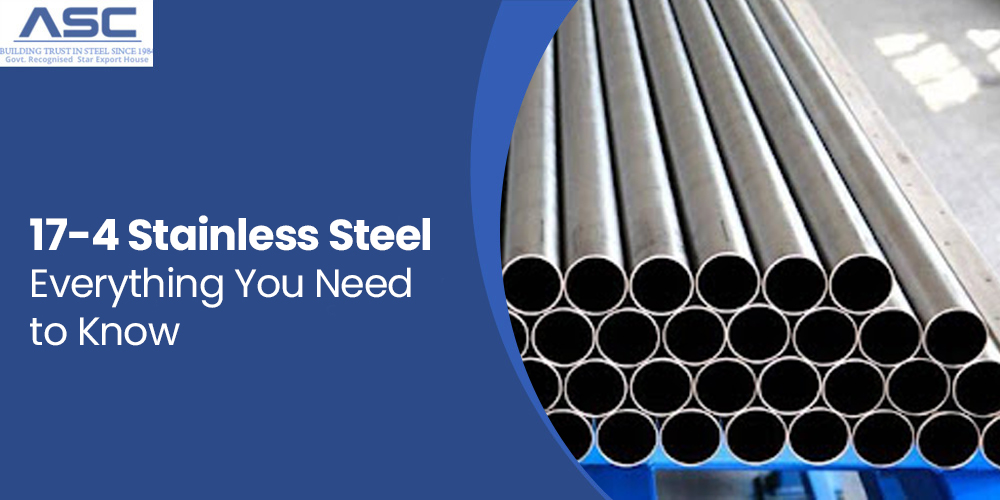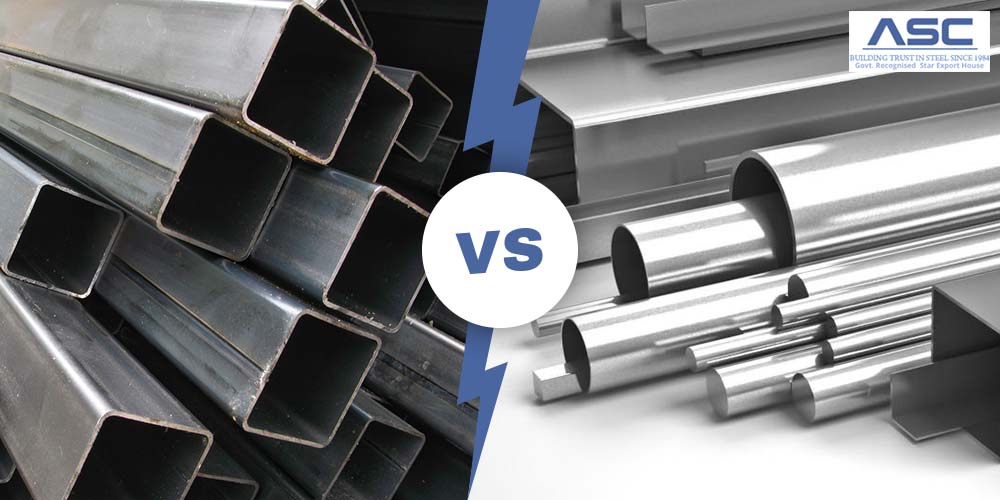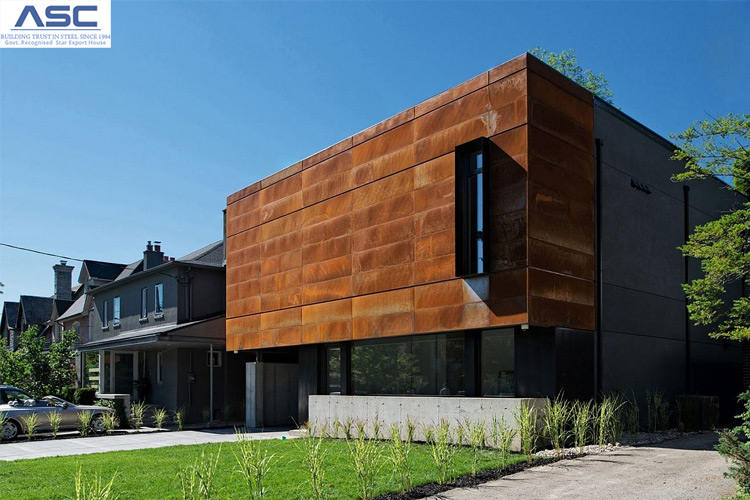17-4 Stainless Steel - Everything You Need to Know
by AMC
Posted on January 29, 2024 at 03:57 PM

17-4 stainless steel, recognized as SAE Type 630, stands as a sought-after alloy renowned for its impressive corrosion resistance, strength, and versatility. Comprising 17% chromium and 4% nickel, this alloy finds its niche in high-temperature applications within the gas, chemical, and aviation industries.
What Is 17-4 Stainless Steel?
Defined by its composition featuring approximately 17% chromium and 4% nickel, 17-4 stainless steel, also
known as SAE Type 630, stands out as a versatile alloy. Primarily coveted for applications in high-temperature
settings within industries such as gas, chemical, and aviation, this alloy boasts a unique combination of
attributes. Its notable corrosion resistance, mechanical properties, toughness, and strength remain
exceptional even in temperatures up to 600 degrees Fahrenheit (316°C). Additionally, 17-4 stainless steel
exhibits superior formability and weldability, differentiating it from other stainless steel grades.
Widely utilized in operations requiring high tensile strength and a moderate level of corrosion resistance,
17-4 stainless steel, specifically in its 17-4 PH form, reigns as the most-used grade among martensitic
precipitation-hardenable alloys. Recognized for maintaining intense tensile strength, ductility, and hardness
at elevated temperatures, it further distinguishes itself by showcasing exceptional corrosion resistance
across diverse conditions. In essence, 17-4 stainless steel proves to be an indispensable choice, seamlessly
blending strength, corrosion resistance, and adaptability in critical industrial applications.
17-4 Stainless Steel Properties
| Condition | Tensile | Yield | Enlongation | Reduction of Area | Hardness |
|---|---|---|---|---|---|
| H900 | 190KSI | 170KSI | 10% | 35% | 35 HRC |
| H1025 | 155KSI | 145KSI | 12% | 45% | 40 HRC |
| H1075 | 145 | 125 | 13 | 45 | 33-39 HRC |
| H1150 | 135 | 105 | 16 | 50 | 28-37 HRC |
| H1150D | 125 | 105 | 16 | 50 | 25-33 HRC |
17-4 Stainless Steel Chemical Composition
| Element | Content (%) |
|---|---|
| Iron, Fe | 73 |
| Chromium, Cr | 15.0 - 17.5 |
| Nickel, Ni | 3.0 - 5.0 |
| Copper, Cu | 3.0 - 5.0 |
| Manganese, Mn | 1.0 |
| Silicon, Si | 1.0 |
| Tantalum, Ta | 0.45 |
| Niobium, Nb (Columbium, Cb) | 0.45 |
| Nb + Ta | 0.15 - 0.45 |
| Carbon, C | 0.070 |
| Phosphorous, P | 0.040 |
| Sulfur, S | 0.030 |
17-4 Stainless Steel Mechanical Properties
| Properties | Metric | Imperial |
|---|---|---|
| Shear modulus | 77.4 GPa | 11200 ksi |
| Elastic modulus | 190-210 GPa | 27557-30458 ksi |
| Poisson's ratio | 0.27-0.30 | 0.27-0.30 |
| Hardness, Brinell | 352 | 352 |
| Hardness, Knoop (estimated from Rockwell C) | 363 | 363 |
| Hardness, Rockwell C | 36 | 36 |
| Hardness, Vickers (estimated from Rockwell C) | 349 | 349 |
17-4 Stainless Steel Physical Properties
| Properties | Metric | Imperial |
|---|---|---|
| Density | 7.75 g/cm3 | 0.280 lb/in³ |
17-4 Stainless Steel Thermal Properties
| Properties | Metric | Imperial |
|---|---|---|
| Thermal expansion co-efficient (@ 21-93°C/69.8-199°F) | 10.8 µm/m°C | 6.00 µin/in°F |
| Thermal conductivity ( for condition H 900 at 149ºC. 22.6 W/mK for H 900 at 482ºC) | 17.9 W/mK | 124 BTU in/hr.ft².°F |
17-4 Stainless Steel Other Designations
| AISI 630 | ASTM A693 (630) | AMS 5342 | MIL-S-81506 |
| AMS 5604 | ASTM A705 (630) | AMS 5343 | SAE J467 (17-4PH) |
| AMS 5622 | MIL C-24111 | AMS 5344 | ASME SA705 |
| AMS 5643 | MIL P-47183 | AMS 5355 | ASME SA564 |
| ASTM A564 (630) | MIL S-81591 | AMS 5825 |
17-4 Stainless Steel Fabrication and Heat Treatment
Machinability
In its annealed condition, Grade 17-4 stainless steel lends itself to machining, producing long and gummy chips. However, when machining in the H1150M condition, a post-machining solution treatment is essential before the final hardening process.
Forming:
This stainless steel grade exhibits mild formability, allowing for a range of shaping possibilities to suit specific fabrication needs.
Welding:
Welding Grade 17-4 stainless steel is achievable through common fusion and resistance welding methods. Notably, the oxyacetylene welding method is not recommended for this alloy due to specific material characteristics.
Heat Treatment:
The heat treatment of Grade 17-4 stainless steel is a precise and critical process. In the condition A, the
material is soaked at 1038°C (1900°F) for 30 minutes and then cooled below 16°C (60°F) to achieve complete
martensite transformation. Further treatment involves heating the material at 482°C (900°F) for 1 hour,
followed by cooling.
For various conditions like H925, H1025, H1075, H1100, and H1150, the solution-treated material undergoes
specific soaking temperatures for 4 hours, followed by cooling in air. In the H1150M condition, the material
is soaked at 760°C (1400°F) for 2 hours, then heated again at 620°C (1150°F) for 4 hours, concluding with a
carefully managed cooling process.
In essence, mastering the intricacies of Grade 17-4 stainless steel's fabrication and heat treatment is key to
unleashing its full potential in diverse industrial applications.
Forging:
The journey of crafting Grade 17-4 stainless steel begins with forging, a meticulous process performed at 1010°C (1850°F). Prior to this, the alloy is carefully soaked at 1177°C (2150°F). However, the saga doesn't end here—post-forging, a crucial solution treatment is imperative before advancing to the final hardening phase.
Hot Working:
Navigating the realm of hot working, Grade 17-4 stainless steel reveals its versatility. Subjected to processes at 1038°C (1900°F), this alloy showcases its adaptability. As with forging, a post-hot working solution treatment becomes a prerequisite before the culmination of the final hardening stage.
Cold Working:
Surprisingly, despite its high initial yield strength, Grade 17-4 stainless steel accommodates cold working using standard techniques. This flexibility adds to the alloy's allure, making it a robust choice for applications demanding resilience and strength.
Annealing:
To refine and optimize its properties, Grade 17-4 stainless steel undergoes annealing at 1038°C (1900°F) for 0.5 hours, followed by a rapid cooling process. This annealing step plays a pivotal role in ensuring the alloy's structural integrity and performance.
Hardening:
Renowned for its high ductility, Grade 17-4 stainless steel lends itself to various conventional forming techniques. However, the strength of this alloy surpasses that of regular steel, necessitating the use of powerful equipment during forming processes. Heavy-duty lubricants come into play during cold working, ensuring seamless and effective shaping of this robust material.
Benefits of 17-4 Stainless Steel
Versatility Across Industries:
17-4 stainless steel, a robust alloy, proves its mettle in diverse industries, including manufacturing and chemical processing. It surpasses other stainless steel varieties in strength, toughness, wear resistance, and fatigue strength, making it a preferred choice for critical applications.
Tailored to Perfection:
The inherent customizability of 17-4 stainless steel positions it as an ideal material across applications—from aerospace to food processing. The alloy's unique properties, encapsulated in 17-4 PH, enable precise tailoring to meet the specific requirements of any task at hand.
Exceptional Strength:
Standing tall with an impressive yield strength of up to 1100-1300 MPa (160-190 ksi), 17-4 steel signifies unparalleled strength, ensuring reliability in the face of demanding conditions.
Formability and Weldability:
Beyond strength, 17-4 stainless steel offers excellent formability and weldability. Processes like shielded fusion and resistance welding seamlessly transform this alloy, enhancing its adaptability for various manufacturing techniques.
Corrosion Resistance:
A standout attribute of 17-4 PH stainless steel is its remarkable resistance to corrosive attacks, outperforming standard hardenable stainless steels. Widely embraced in food preparation, aerospace components, oil and gas, and chemical processing, this alloy excels in environments where durability is paramount.
Superior Toughness and Resistance:
Renowned for providing superior toughness and strength across diverse temperatures, 17-4 PH stainless steel maintains low thermal expansion. This feature allows it to develop high magnetic permeability, making it invaluable for applications such as cores, efficient motor laminations, and more.
Extreme Environment Protection:
The material's exceptional performance in extreme environments solidifies its standing as the go-to choice for applications demanding high levels of durability.
Radiation-Resistant Design:
Given its high resistance to corrosion, 17-4 stainless steel can be ingeniously employed in the design of structures for radioactive storage. Its unique strength and resistance properties make it an optimal material for constructing buildings that store hazardous materials, showcasing its versatility across a spectrum of applications.
Key Features of 17-4 Stainless Steel
1. Density:
With a density of 0.280 lb/in3 (7.8 g/cm3), 17-4 stainless steel stands out as an ideal material for applications demanding a combination of high strength and corrosion resistance. This optimal density ensures its suitability across diverse industries.
2. Hardness:
A standout property of 17-4 PH is its remarkable hardness, particularly when subjected to heat treatment. This feature positions it as an exceptional choice for applications requiring not only high strength but also superior wear resistance. The hardness of 17-4 stainless steel makes it resilient in challenging conditions.
3. Machinability:
Versatility defines 17-4 stainless steel, primarily owing to its high machinability. This attribute broadens its applicability, allowing its use across a spectrum of purposes in various industries. The metal's machinability contributes to its adaptability and ease of use in manufacturing processes.
4. Heat Treatment - Precipitation Hardening:
The age-hardening process, also known as precipitation hardening, plays a crucial role in enhancing the strength of 17-4 stainless steel. This method involves using existing particles or solid impurities to fortify the alloy. To initiate the age-hardening process, a solution treatment is performed, followed by quenching and aging.
- Solution Treatment: Conducted at 1050 °C for 30 minutes.
- Precipitation Hardening: Takes place at temperatures ranging from 480 °C to 760 °C and typically spans two to four hours.
Applications of 17-4 Stainless Steel: Unleashing Strength and Versatility
Renowned for its exceptional strength, corrosion resistance, and toughness, 17-4 stainless steel finds a diverse array of applications across several industries. The versatility of this alloy makes it a material of choice in various demanding environments. Here are some key sectors where 17-4 stainless steel shines:
1. Aerospace Industry:
In the aerospace sector, where high-performance materials are crucial, 17-4 stainless steel is often employed due to its robust strength, corrosion resistance, and reliability. It finds applications in the production of aircraft components, ensuring durability in challenging conditions.
2. Medical Sector:
The medical industry benefits from the use of 17-4 stainless steel in manufacturing medical devices and equipment. The alloy's corrosion resistance is particularly valuable in medical applications where hygiene and longevity are essential.
3. Food Processing Industry:
Given its resistance to corrosion and ability to withstand harsh cleaning processes, 17-4 stainless steel is a preferred material in the food processing industry. It contributes to the manufacturing of equipment such as food handling and packaging machinery.
4. Construction:
In construction, 17-4 stainless steel is employed for its strength and durability. It is used in structural components and elements where resistance to corrosion and high tensile strength are vital.
5. Oil and Gas Sector:
The harsh and corrosive environments of the oil and gas industry demand materials that can withstand challenging conditions. 17-4 stainless steel is utilized in various components, including valves and fittings, ensuring longevity and performance in these demanding applications.
6. Transportation:
From automotive components to maritime applications, 17-4 stainless steel is a preferred choice in the transportation industry. Its combination of strength and corrosion resistance makes it suitable for various components, ensuring reliability and safety.
7. Manufacturing of Gears, Valves, Pumps, and Fasteners:
The alloy's high strength and corrosion resistance make it an ideal candidate for manufacturing critical components such as gears, valves, pumps, and fasteners. These components play pivotal roles in various industrial processes.
8. Molds and Dies Production:
In the manufacturing sector, 17-4 stainless steel is often chosen for the production of molds and dies. Its durability and resistance to wear contribute to the longevity and reliability of these essential tools.
Conclusion: The Versatile Impact of 17-4 Stainless Steel
In summary, 17-4 stainless steel stands as a versatile powerhouse, embodying a perfect fusion of strength,
corrosion resistance, and toughness. Its significance spans critical sectors, including aerospace, medical,
food processing, construction, oil and gas, and transportation. Whether crafting gears, valves, or
contributing to the structural integrity of aircraft, this alloy consistently proves its mettle, excelling in
diverse applications.
Its adaptability is a hallmark, offering a resilient solution for molds and dies in manufacturing and enduring
the rigors of harsh environments in the oil and gas industry. As a material of choice, 17-4 stainless steel
continues to elevate industries, ensuring longevity, reliability, and performance across a spectrum of
applications.
.jpg)
Alloy Steel vs. Stainless Steel
Alloy steel is a type of steel that is made by combining two or more different metals or elements to improve its properties.

